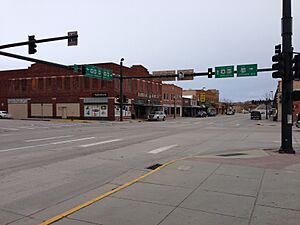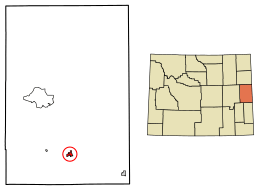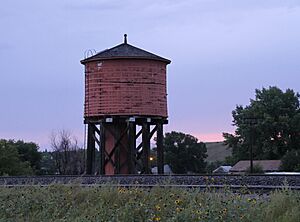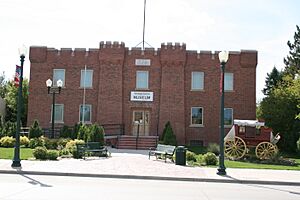Lusk, Wyoming facts for kids
Quick facts for kids
Lusk, Wyoming
|
|
|---|---|

Downtown. Intersection of US Highways 18, 20, and 85
|
|
| Motto(s):
"The Little Town With Big Possibilities"
|
|

Location of Lusk in Niobrara County, Wyoming.
|
|
| Country | United States |
| State | Wyoming |
| County | Niobrara |
| Incorporated | 1886 |
| Government | |
| • Type | City Council |
| Area | |
| • Total | 2.07 sq mi (5.36 km2) |
| • Land | 2.07 sq mi (5.36 km2) |
| • Water | 0.00 sq mi (0.00 km2) |
| Elevation | 5,020 ft (1,530 m) |
| Population
(2020)
|
|
| • Total | 1,541 |
| • Density | 745.2/sq mi (287.7/km2) |
| Time zone | UTC-7 (Mountain (MST)) |
| • Summer (DST) | UTC-6 (MDT) |
| ZIP code |
82225
|
| Area code(s) | 307 |
| FIPS code | 56-48530 |
| GNIS feature ID | 1591129 |
| Website | Town of Lusk, Wyoming |
Lusk is a small town in Wyoming, USA. It is the main town, or county seat, of Niobrara County, Wyoming. Lusk is located in an area called the High Plains.
The town was started in July 1886. It was founded by Frank S. Lusk, a well-known rancher from Wyoming. He was also a partner in the Western Live Stock Company. Today, raising cattle is still the most important business in Lusk.
In 2020, about 1,541 people lived in Lusk. It is known for being the county seat of the county with the fewest people. This county is in the state with the fewest people in the United States.
Contents
History of Lusk
Early Days and Gold Rush
The Black Hills Gold Rush brought many people looking for gold to the Wyoming Territory. A special stagecoach route was set up between Cheyenne, Wyoming, and Deadwood, South Dakota. This route carried goods like food and drinks. It also carried valuable items like gold bricks.
This stagecoach route ran from 1876 to 1887. After that, the Wyoming Central Railway took its place.
Frank S. Lusk's Role
Frank S. Lusk (1857–1930) was a rancher in Wyoming. He also owned shares in the Wyoming Central Railway. He first lived in Cleveland, Ohio, then moved to Denver, Colorado in 1876. There, he helped build the Western Live Stock Company.
In 1877, Lusk visited the Wyoming Territory. He was very impressed by the people and the land. In 1879, his company decided to move to a new area. Lusk chose Wyoming because he liked the people he had met there.
In 1880, Lusk and his company arrived in Wyoming. They set up the Node Ranch, about 15 miles (24 km) east of where Lusk is today. A year later, he bought land that included the Running Water Stage Station. This land had old buildings used by the stagecoach route. Lusk started a hay ranch there. He also set up his horse ranch at the spot where the town of Lusk would later be built.
The Lusk Post Office
After setting up his ranches, Lusk realized the closest post office was far away. It was about 15 miles (24 km) southeast of his hay ranch. Getting mail meant a 40-mile (64 km) round trip ride.
One of his business partners suggested he open a post office at his ranch. This would make getting mail much easier. When Lusk sent in the application, he forgot to write down a name for the post office. The person helping him suggested the name "Lusk." That is how the post office, and later the town, got its name.
Wyoming Central Railway and Town Growth
In 1886, a railroad company wanted to build a line through Wyoming. They needed to follow state laws to do this. So, the Wyoming Central Railway was created. Frank Lusk was named a director and the only local owner of the company. The company's official papers listed Lusk, Wyoming, as its main office.
Even though Lusk was the only post office on the planned railway line, the town was not officially started until July 1886. That's when railroad engineers drew up the first map for the town. The towns of Douglas and Casper were also started in the same way by Lusk for the railway.
After 1900, silver was found near Lusk. This brought many miners to the area. By the 1950s, the town's growth became steady. Raising cattle became the main business again, taking over from mining.
Geography
Lusk is located at 42°45′38″N 104°27′10″W / 42.76056°N 104.45278°W. The town covers an area of about 2.07 square miles (5.36 km²), all of it land. It is about 20 miles (32 km) west of the Nebraska border. Lusk sits about 5,000 feet (1,530 m) above sea level. It is surrounded by the southeastern part of the Black Hills National Forest.
Climate
Lusk has a dry humid continental climate. This means it has cold, dry winters. Summers are hot and can be humid.
| Climate data for Lusk, Wyoming | |||||||||||||
|---|---|---|---|---|---|---|---|---|---|---|---|---|---|
| Month | Jan | Feb | Mar | Apr | May | Jun | Jul | Aug | Sep | Oct | Nov | Dec | Year |
| Record high °F (°C) | 69 (21) |
69 (21) |
79 (26) |
87 (31) |
94 (34) |
105 (41) |
105 (41) |
102 (39) |
100 (38) |
87 (31) |
76 (24) |
70 (21) |
105 (41) |
| Mean daily maximum °F (°C) | 33.6 (0.9) |
38.3 (3.5) |
45.7 (7.6) |
54.7 (12.6) |
64.6 (18.1) |
75.7 (24.3) |
83.3 (28.5) |
82.5 (28.1) |
72.6 (22.6) |
59.9 (15.5) |
43.3 (6.3) |
35.7 (2.1) |
57.5 (14.2) |
| Daily mean °F (°C) | 21.9 (−5.6) |
26.3 (−3.2) |
33.2 (0.7) |
41.7 (5.4) |
51.3 (10.7) |
61.3 (16.3) |
68.0 (20.0) |
66.7 (19.3) |
56.8 (13.8) |
45.0 (7.2) |
31.0 (−0.6) |
23.4 (−4.8) |
43.9 (6.6) |
| Mean daily minimum °F (°C) | 10.1 (−12.2) |
14.3 (−9.8) |
20.7 (−6.3) |
28.6 (−1.9) |
38.0 (3.3) |
46.9 (8.3) |
52.7 (11.5) |
50.9 (10.5) |
40.9 (4.9) |
30.0 (−1.1) |
18.6 (−7.4) |
11.0 (−11.7) |
30.2 (−1.0) |
| Record low °F (°C) | −38 (−39) |
−33 (−36) |
−20 (−29) |
−9 (−23) |
8 (−13) |
24 (−4) |
33 (1) |
31 (−1) |
6 (−14) |
−8 (−22) |
−24 (−31) |
−36 (−38) |
−38 (−39) |
| Average precipitation inches (mm) | 0.59 (15) |
0.62 (16) |
1.23 (31) |
2.25 (57) |
2.74 (70) |
2.13 (54) |
1.96 (50) |
1.00 (25) |
1.29 (33) |
1.28 (33) |
0.77 (20) |
0.65 (17) |
16.51 (421) |
| Source 1: NOAA (normals, 1971–2000) | |||||||||||||
| Source 2: The Weather Channel (Records) | |||||||||||||
Population of Lusk
| Historical population | |||
|---|---|---|---|
| Census | Pop. | %± | |
| 1890 | 253 | — | |
| 1900 | 180 | −28.9% | |
| 1910 | 414 | 130.0% | |
| 1920 | 2,092 | 405.3% | |
| 1930 | 1,218 | −41.8% | |
| 1940 | 1,814 | 48.9% | |
| 1950 | 2,089 | 15.2% | |
| 1960 | 1,890 | −9.5% | |
| 1970 | 1,495 | −20.9% | |
| 1980 | 1,650 | 10.4% | |
| 1990 | 1,504 | −8.8% | |
| 2000 | 1,447 | −3.8% | |
| 2010 | 1,567 | 8.3% | |
| 2020 | 1,541 | −1.7% | |
| U.S. Decennial Census 1870-2000 census |
|||
2010 Census Information
In 2010, there were 1,567 people living in Lusk. There were 658 households. Most of the people living in Lusk were White (95.7%). A small number were Native American (1.1%) or Asian (0.6%). About 2.5% of the population was Hispanic or Latino.
About 22.6% of households had children under 18. The average age in Lusk was 43.5 years old. About 18.3% of residents were under 18.
Arts and Culture
Annual Events
- Legend of Rawhide: This is a special yearly event.
Museums and Sights
- The Stagecoach Museum: Learn about old stagecoaches here.
- Silver Sage Bison Ranch: See bison at this ranch.
- Paleo Dinosaur Park: Explore dinosaurs at this park.
- The grave of Mother Featherlegs: This historic grave is about ten miles south of Lusk.
Parks and Recreation
The Parks Department in Lusk offers fun activities. They have a golf course and a swimming pool. The Lusk Recreation Department also has sports programs for kids and adults.
Sports Programs
- Summer leagues include softball for adults.
- Youth baseball and soccer are also offered.
- The department also has a summer "Art in the Park" program.
Town Parks and Pool
The Parks and Recreation Department takes care of three parks:
- Washington Park
- Northside Park
- Audrey Park
All parks have playground equipment and are open from May to October. The town swimming pool, called "Lusk Plunge," is at Northside Park.
Golf Course
The department also manages the Lusk Municipal Golf Course. It has nine holes and opened in 1942. The course is west of town and hosts several tournaments each year.
Education
Public schools in Lusk are part of Niobrara County School District #1.
- Lusk Elementary/Middle School serves students from kindergarten to 8th grade.
- Niobrara County High School is for grades 9-12.
- The Wyoming Virtual Academy, an online public school for K-12, is also based in Lusk.
Lusk also has a public library, called the Niobrara County Library.
Media
The main local newspaper in Lusk is the Lusk Herald. It offers both print and online versions. For television, residents can use Comcast Cable, Dish Network, and DIRECTV. While Lusk does not have its own local TV stations, news from around Wyoming is available. This includes channels like KTWO-TV (ABC), KLWY (FOX), and KGWN (CBS).
Infrastructure
Highways and Roads
Lusk is connected by several important highways:
 U.S. Hwy 18
U.S. Hwy 18 U.S. Hwy 20 (runs east–west through Lusk)
U.S. Hwy 20 (runs east–west through Lusk) U.S. Hwy 85 (runs north–south through Lusk)
U.S. Hwy 85 (runs north–south through Lusk) WYO 273 (runs along the western edge of Lusk)
WYO 273 (runs along the western edge of Lusk)
A Tesla Supercharger station, where electric cars can charge quickly, opened in Lusk in 2014.
Local Roads
- Beer Can Road: A local road running east and north from Lusk.
- Twentyeight Road: A local road running northwest from Lusk.
Airport
The Lusk Municipal Airport is located 3 miles (5 km) east of town. It is managed by the Department of Public Works.
Public Transit
The Niobrara Senior Center provides basic transportation services. These services are for people in Lusk and Niobara County.
Utilities
The Department of Public Works makes sure Lusk has important services. These include water, electricity, street maintenance, sewer, trash collection, and recycling.
Safety and Healthcare
Lusk has services to keep people safe and healthy. These include:
- Law enforcement (police)
- Medical emergency transport (ambulances)
- Fire protection from the Lusk Volunteer Fire Department.
As of 2012, the fire department had 21 trained volunteer firefighters. They receive training and certifications to help keep the community safe.
Notable People
- Thomas Wilson Brown (born 1972), actor
- Dick Ellsworth (1940–2022), a baseball pitcher in Major League Baseball
- Douglas W. Owsley (born 1951), a scientist who studies human bones
- James G. Watt (1938–2023), a former government official who served as United States Secretary of the Interior
See also
 In Spanish: Lusk (Wyoming) para niños
In Spanish: Lusk (Wyoming) para niños




